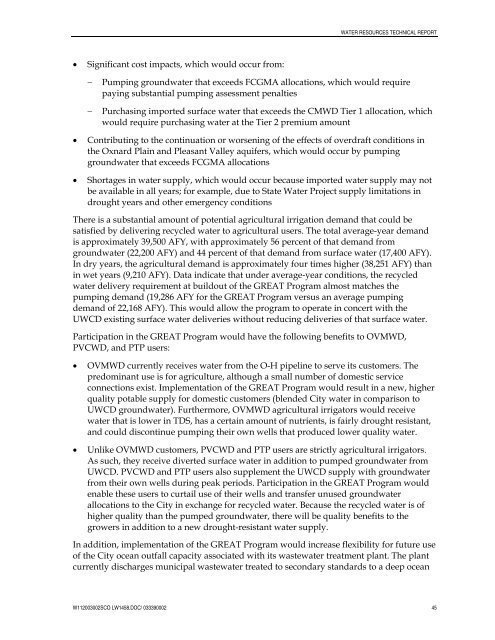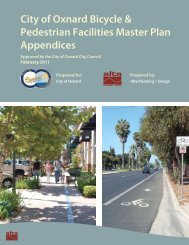View File - Development Services - City of Oxnard
View File - Development Services - City of Oxnard
View File - Development Services - City of Oxnard
Create successful ePaper yourself
Turn your PDF publications into a flip-book with our unique Google optimized e-Paper software.
WATER RESOURCES TECHNICAL REPORT• Significant cost impacts, which would occur from:−−Pumping groundwater that exceeds FCGMA allocations, which would requirepaying substantial pumping assessment penaltiesPurchasing imported surface water that exceeds the CMWD Tier 1 allocation, whichwould require purchasing water at the Tier 2 premium amount• Contributing to the continuation or worsening <strong>of</strong> the effects <strong>of</strong> overdraft conditions inthe <strong>Oxnard</strong> Plain and Pleasant Valley aquifers, which would occur by pumpinggroundwater that exceeds FCGMA allocations• Shortages in water supply, which would occur because imported water supply may notbe available in all years; for example, due to State Water Project supply limitations indrought years and other emergency conditionsThere is a substantial amount <strong>of</strong> potential agricultural irrigation demand that could besatisfied by delivering recycled water to agricultural users. The total average-year demandis approximately 39,500 AFY, with approximately 56 percent <strong>of</strong> that demand fromgroundwater (22,200 AFY) and 44 percent <strong>of</strong> that demand from surface water (17,400 AFY).In dry years, the agricultural demand is approximately four times higher (38,251 AFY) thanin wet years (9,210 AFY). Data indicate that under average-year conditions, the recycledwater delivery requirement at buildout <strong>of</strong> the GREAT Program almost matches thepumping demand (19,286 AFY for the GREAT Program versus an average pumpingdemand <strong>of</strong> 22,168 AFY). This would allow the program to operate in concert with theUWCD existing surface water deliveries without reducing deliveries <strong>of</strong> that surface water.Participation in the GREAT Program would have the following benefits to OVMWD,PVCWD, and PTP users:• OVMWD currently receives water from the O-H pipeline to serve its customers. Thepredominant use is for agriculture, although a small number <strong>of</strong> domestic serviceconnections exist. Implementation <strong>of</strong> the GREAT Program would result in a new, higherquality potable supply for domestic customers (blended <strong>City</strong> water in comparison toUWCD groundwater). Furthermore, OVMWD agricultural irrigators would receivewater that is lower in TDS, has a certain amount <strong>of</strong> nutrients, is fairly drought resistant,and could discontinue pumping their own wells that produced lower quality water.• Unlike OVMWD customers, PVCWD and PTP users are strictly agricultural irrigators.As such, they receive diverted surface water in addition to pumped groundwater fromUWCD. PVCWD and PTP users also supplement the UWCD supply with groundwaterfrom their own wells during peak periods. Participation in the GREAT Program wouldenable these users to curtail use <strong>of</strong> their wells and transfer unused groundwaterallocations to the <strong>City</strong> in exchange for recycled water. Because the recycled water is <strong>of</strong>higher quality than the pumped groundwater, there will be quality benefits to thegrowers in addition to a new drought-resistant water supply.In addition, implementation <strong>of</strong> the GREAT Program would increase flexibility for future use<strong>of</strong> the <strong>City</strong> ocean outfall capacity associated with its wastewater treatment plant. The plantcurrently discharges municipal wastewater treated to secondary standards to a deep oceanW112003002SCO LW1458.DOC/ 033390002 45
















